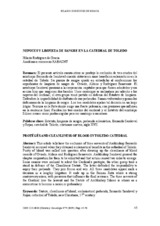Nepotes y limpieza de sangre en la Catedral de Toledo
Protégés and cleanliness of blood in Toledo Catedral
Autor
Rodríguez de Gracia, Hilario
Editor
Universidad de Córdoba, UcoPressFecha
2019Materia
EstatutosLimpieza de sangre
Prebenda eclesiástica
Sandoval y Rojas, Bernardo de, 1546-1618
Catedral de Toledo
Cristianos nuevos
Siglo XVII
Statutes
Cleanliness of blood
Ecclesiastical prebends
Cathedral of Toledo
New Christians
17th century
METS:
Mostrar el registro METSPREMIS:
Mostrar el registro PREMISMetadatos
Mostrar el registro completo del ítemResumen
El presente artículo cuenta cómo se produjo la exclusión de tres criados del arzobispo Bernardo de Sandoval cuando obtuvieron unos beneficios eclesiásticos en la catedral de Toledo. Su pureza de sangre quedó en entredicho al confeccionar los expedientes de limpieza de sangre de Oviedo, Aldana y Rodríguez Benavente. El arzobispo Sandoval presionó a la corporación capitular para que fuesen admitidos y esa acción hizo que surgieran dos bandos. Unos canónigos se inclinaban por admitir a los nepotes del cardenal; el otro grupo tomó partido en defensa del Estatuto de limpieza. Defendían la imposibilidad de disfrutar de sus prebendas. Suman voluntades y ganan los defensores de la limpieza de sangre. Los tres candidatos apelan tal decisión en un largo litigio. Termina en la Rota donde surge una fuerte polémica, con presiones que influyen en la sentencia final. Pierden los tres criados del cardenal y el Estatuto del arzobispo Silíceo renace como piedra angular para ser canónigo o racionero. This article tells how the exclusion of three servants of Archbishop Bernardo Sandoval occurred when they obtained ecclesiastical benefits in the cathedral of Toledo. Purity of blood was called into question after drawing up the cleanliness of blood records of Oviedo, Aldana and Rodríguez Benavente. Archbishop Sandoval pressed the chapter corporation for them to be admitted and that action caused two sides to emerge. Some canons were inclined to admit the Cardinal´s protégés; the other group took a stand in defence of the Cleanliness Statute. The latter defended the impossibility to enjoy their prebends. They join forces and win. All three candidates appeal such a decision in a lengthy litigation. It ends up in the Roman Rota where a strong controversy arises, with pressures that influence the final sentence. The three servants of the Cardinal lose the lawsuit and the Statute of Archbishop Siliceo is reborn as a cornerstone to become a canon or prebendary.

